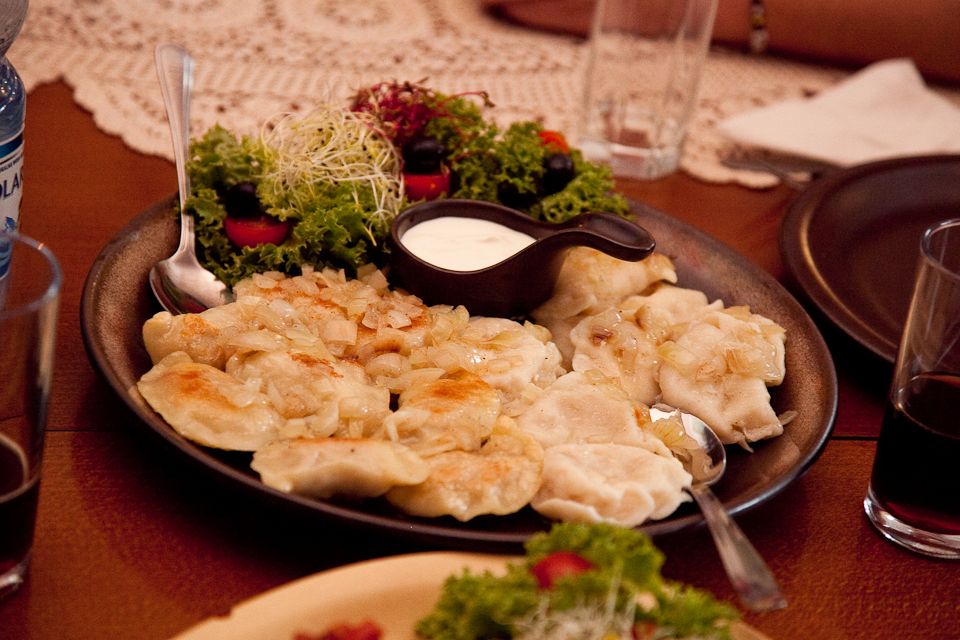So you decided to pay a visit to that mysterious country that lies in the very heart of Europe - Poland. Taking into consideration that the country was pretty much separated from the rest of the world during 50 years of communism, you might wonder - what is there to eat?
Once you start exploring Polish cuisine you will most definitely be surprised. Poland has a lot to offer to people who are looking to challenge their taste buds. If you start digging into Polish traditional recipes, you might come across dishes that you might not even want to try, (soup made of duck blood - anyone?) but some of them are so delicious that you will simply want more and more. On our food tour in Krakow and Wroclaw, we serve all traditional must try dishes so that you can experience all the dishes once you book a food tour with us.
One of the must try Polish dishes are definitely pierogi, (Polish dumplings). They come in a variety of shapes and sizes and are served both on special occasions (like Christmas Eve) and as regular everyday meals. There are tons of different fillings to choose from (meat, potatoes, cottage cheese, lentils, spinach or all kinds of berries if you are a sweet tooth), so it’s difficult to ever get bored of that dish. The best ones are handmade pierogis that are prepared by an experienced Polish housewife. If you ever have a chance to pay a visit to a Polish household, try to persuade the lady of the house to prepare that dish for you. Yammi!
credit. Delicious Poland
Another interesting dish are placki ziemniaczane (potato pancakes), which in times of economic difficulties in 19th century often replaced bread among the peasants. They are made of grated and ground potatoes, flour and eggs, than deep fried in oil and topped with a variety of condiments. As with pierogis, you can choose between a savoury option (potato pancakes served with sour cream or goulash) or a sweet one (the same potato pancakes served with applesauce or sugar), they may also be served plain. If you’re really hungry, go for the pancakes with goulash. The rich, savory Polish goulash is made from pork and is a perfect topping for that delicious dish.
credit: Delicious Poland
You cannot leave Poland without trying traditional Polish soups. The most intriguing ones are Barszcz (the beetroot soup) and Zurek. Barszcz is always served on Christmas Eve in a company of cute little dumplings called “uszka” (which literally means “little ears”); these always have a mushroom and sauerkraut filling. The popularity of borscht has spread throughout Eastern Europe and the former Russian Empire, so you might find different types of borscht in each of the Eastern European countries. The Polish version is made of beets, meat stock, a bit of sugar, vinegar, salt, and pepper. Some recipes consider adding other vegetables like carrots, parsley roots, white cabbage or even tomatoes, but the quintessence of the soup is beetroot, which gives the dish a distinctive red color.
Zurek is quite different. Very popular during Easter, this soup is made of soured rye flour (akin to sourdough) and is served with meat (usually boiled pork sausage or pieces of smoked sausage, bacon or ham). The recipe varies from region to region (in Silesia, for example, people add mashed potatoes to the soup), but most Poles will not accept Zurek without halved hard-boiled egg inside. It’s simply a must!
If during your stay in Poland you somehow end up partying with some Poles, Zurek is then highly recommended the day after - there is no better cure for a hangover!
Credit: Milli Studio
Another suggestion for culinary adventurous travellers is “Golabki” ( literally “little pigeons), which are Polish cabbage rolls. To make them you need soft-boiled cabbage leaves and some minced pork or beef. You also need to have skillful hands - the cabbage leaves need to be wrapped around the meat! The meat is not the only delicacy inside the rolls. There is also rice or barley, chopped onions and herbs. The rolls need to be baked in the oven in a casserole dish and served with a creamy tomato sauce.
Poles are definitely creative in the kitchen and are able to create a dish from nothing. A good example of that culinary ability is Bigos. If you need to clean out your freezer and use up leftovers from other meat dishes - make yourself some Bigos! Worth trying if you ever feel nostalgic after your trip to Poland. All you need are assorted kinds of meat chopped into small chunks and a mixture of sauerkraut (pickled cabbage) and shredded fresh white cabbage; you mix all ingredients and the result is that delicious Polish stew. A couple of good quality shots of vodka and you feel like you’re in Poland again!
We are Delicious Poland. We run memorable and personal culinary tours in Krakow, Wroclaw and Warsaw. Join us and experience the tastes of Poland.




